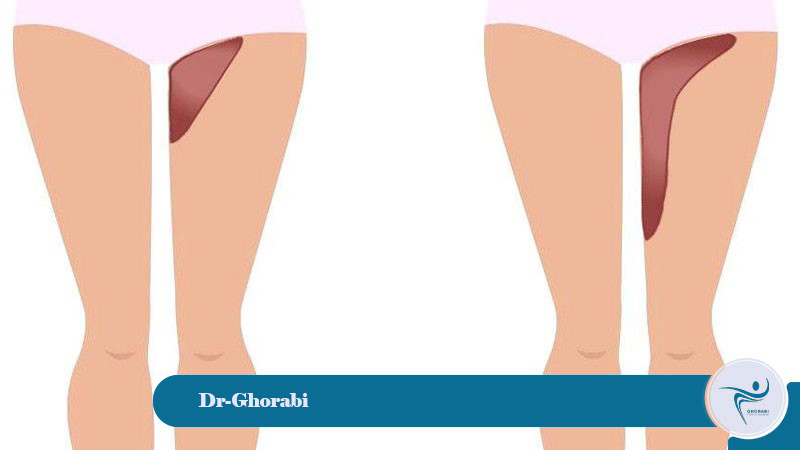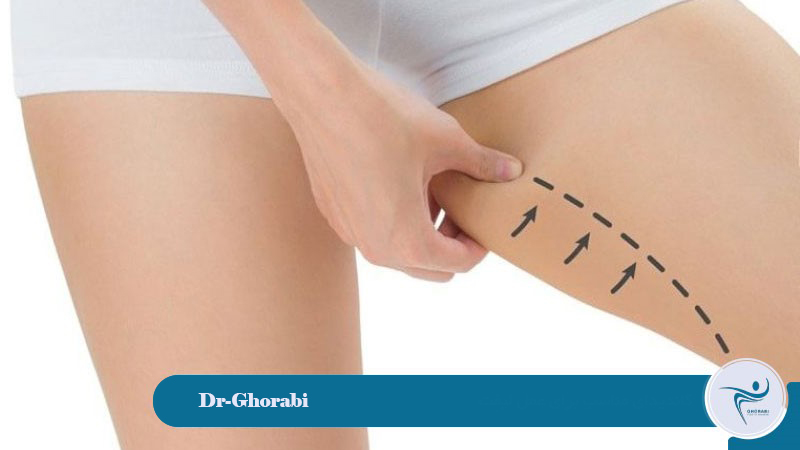In a thighplasty procedure, a significant amount of excess skin and fat is removed from the thigh area, resulting in a well-contoured and aesthetically pleasing appearance in the thighs. The primary goal of this surgery is to tighten and smooth the thigh skin in individuals who have experienced sagging and looseness in this area after substantial weight loss.
Steps for a Thigh Lift Procedure
Thigh lift, also known as thighplasty, is a cosmetic surgery procedure to improve the shape of the thighs. This procedure can be considered a part of body sculpting and fitness procedures. Like all cosmetic procedures, a thigh lift begins with anesthesia and an incision. The steps for performing a thigh lift are as follows:
Types of incisions in thigh reduction surgery (thighplasty)
There are two common techniques for thigh lift surgery, short-scar surgery and vertical-scar surgery. In both procedures, the plastic surgeon may use liposuction or lipomatic to remove excess fat and create a smooth, shapely appearance.
Types of surgical thigh lift methods (thighplasty)
Thigh lift surgery is performed using various methods, depending on the degree of skin sagging and the target area. These methods include inner thigh lift, mid-thigh lift, and outer thigh lift, each targeting a specific area and employing different techniques. Below, we will examine the types of thigh lift methods.
Ideal candidates for thigh lift surgery; who can undergo this procedure?
Individuals who have experienced severe weight loss are usually the best candidates for a vertical scar technique or thigh lift surgery. These individuals will require such surgeries due to the problem of loose and sagging skin in all parts of their thighs. This surgery can be performed on individuals of all ages, provided they are completely healthy and do not have underlying medical conditions. Suitable candidates for thigh lift surgery are as follows:
- Individuals who have stabilized their weight.
- Individuals who are physically healthy and do not suffer from diseases that might interfere with the surgical process.
- Individuals whose thighs are sagging, loose, or have a saddlebag deformity.
- Individuals whose thighs are disproportionately larger than their upper body.
- Individuals who do not suffer from addiction, smoking, or alcohol consumption.
- Individuals who have excess soft tissue in their inner and outer thigh areas.
Considering these conditions, those who intend to undergo this surgery can, through specialized consultation from reputable clinics and the best cosmetic doctor in Tehran.
Important points before thighplasty surgery
Before undergoing various types of body cosmetic surgeries such as Abdo-Lipo, brachioplasty, or thigh lift surgery, you will have a consultation session with a plastic surgeon. In the pre-operative thighplasty session, you should express your expectations regarding the procedure. The doctor will also advise you on several points before the operation, the most important of which are as follows:
- For two weeks before thighplasty surgery, stop smoking and consuming alcoholic beverages.
- If you continue to smoke, the surgeon will refuse to perform the operation.
- Avoid using blood thinners, anti-inflammatory drugs, and herbal supplements.
- Examination and performing necessary tests for thigh surgery are essential.
- If you are taking any specific medication, be sure to report this to the doctor, as the doctor may recommend changes in how you take them.
By observing these tips, you can experience the surgical process with greater safety and more desirable results.
Post-operative care for thigh lift surgery
After surgery, bruising, swelling, and wounds are observed in the affected area. To reduce swelling and accelerate the healing process, the use of compression garments for the thigh area is essential. In some cases, tubes are placed in this area to drain excess fluids and blood, reducing the likelihood of infection.
Stitches are usually removed two weeks after the operation, and medications for pain and swelling control are prescribed to the patient, which must be taken according to the doctor’s instructions. 48 hours after surgery, the patient can shower; additionally, the patient can return to work after 7 to 10 days. However, to shorten the recovery process, attention to the following points is essential:
- Showering and contact of wounds with water are prohibited for up to 48 hours after surgery.
- In the first few weeks, activity should be limited, and pressure on the legs should be avoided.
- The use of a Western-style toilet is recommended.
- Sexual intercourse is prohibited for at least two weeks after surgery.
- One month after surgery, the patient can perform light exercise. After two to three months, exercises like cycling are possible.
By strictly observing these points, the recovery process is accelerated and the patient can return to their daily activities more quickly.
Complications of thighplasty surgery
After thigh lift surgery, swelling and bruising usually occur in the thigh area, which is natural. In the first few days after the operation, the individual may experience some pain; also, there is a possibility of infection in the operated areas, which requires special care. In some cases, the thighs may not be completely symmetrical after surgery. Scarring remains temporarily but will fade over time. Furthermore, numbness may occur at the surgical site, which usually improves after some time.
Thighplasty; an effective solution for correcting sagging and laxity of the thigh skin.
Thigh lift or thighplasty is a form of body contouring surgery that is performed to remove sagging skin in the thigh area. This procedure is suitable for people who have excess skin and sagging in this area after significant weight loss. During this surgery, excess skin and fat are removed from the thigh area, smoothing and tightening the skin. This surgery is performed in a variety of ways, including short or vertical incisions.
If you decide to undergo thighplasty, you can benefit from the consulting services of Dr. Ghorabi, a cosmetic surgeon, for further advice and more detailed information about this surgery and confidently take a step towards having more beautiful thighs.
About DR. Ghorabi
Get to know/Meet Dr. Ghorabi.

About DR. Ghorabi
Get to know/Meet Dr. Ghorabi.

Fellow of the American Academy of Facial Plastic and Reconstructive Surgery (AAFPRS) or a similar organization such as the American Society of Plastic Surgeons (ASPS).

Official member of the International Society of Plastic and Aesthetic Surgeons

Official member of the Iranian Association of Plastic and Reconstructive Surgeons
FAQs
Who can undergo thighplasty?
Individuals experiencing sagging and loose thigh skin after significant weight loss, as well as those with disproportionate thighs, are considered the best candidates for this procedure.
Is thighplasty surgery painful?
thighplasty surgery is usually performed under general anesthesia, so you will not feel any pain during the operation. After the operation, there may be some minor pain and discomfort, which can be controlled with prescribed medications.
How long is the recovery time after a thighplasty surgery?
Initial recovery usually takes a few weeks, but it may take a few months to see the final results.
How long after surgery can I return to daily activities?
Usually, after one week, you can return to your workplace, but for sports or strenuous activities, you must wait at least two to three months.
Does a scar remain from thighplasty surgery?
After surgery, the scar may be temporarily visible, but it gradually fades over time.




